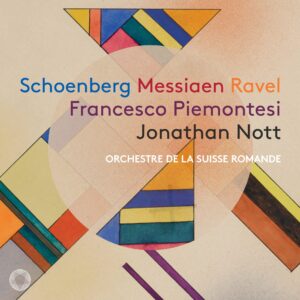Piano concertos and exotic birds
Francesco Piemontesi and the Orchestre de la Suisse Romande play Schönberg, Messiaen and Ravel.

On its latest CD for Pentatone, the Orchestre de la Suisse Romande presents a successful compilation of works of classical modernism, whereby not only the selection but also the order of the recording is convincing. First up is Maurice Ravel's famous Piano Concerto in G major from 1931, followed by Olivier Messiaen's Oiseaux exotiques The "trilogy" concludes with Schönberg's Piano Concerto op. 42 from 1942.
Under the direction of its chief conductor Jonathan Nott, the orchestra plays with great precision and versatility. In Schönberg's Piano Concerto, with its hidden autobiographical program, the four parts of the formal one-movement work are clearly audible: one example is the expressive gesture of the second section, which leads abruptly and movingly into the sombre and tragic third section, a kind of funeral march. However, the orchestra also has a first-class pianist at its side, Francesco Piemontesi, who has an excellent command of Schönberg's tonal language in terms of touch and interpretation.
Somewhat less convincing are the Oiseaux exotiques turned out. The orchestra sometimes "chirps" a little too pompously, which is already announced at the beginning with the first two horn calls of the Indian Maina and reaches its climax in the large tutti of the main section. Piemontesi does, however, provide relaxation and finesse.
If the works by Schönberg and Messiaen are completely tailored to Jonathan Nott's style of interpretation, Ravel's witty and varied piano concerto raises a few question marks. The first movement with its jazz overtones lacks a bit of sparkling esprit and the second the French lightness. The Presto, on the other hand, is highly concise and virtuosically played by Piemontesi, an ideal lead-in to Messiaen's exotic birds.
Schoenberg, Messiaen, Ravel. Francesco Piemontesi, Orchestre de la Suisse Romande, Jonathan Nott. Pentatone PTC 5186 949







